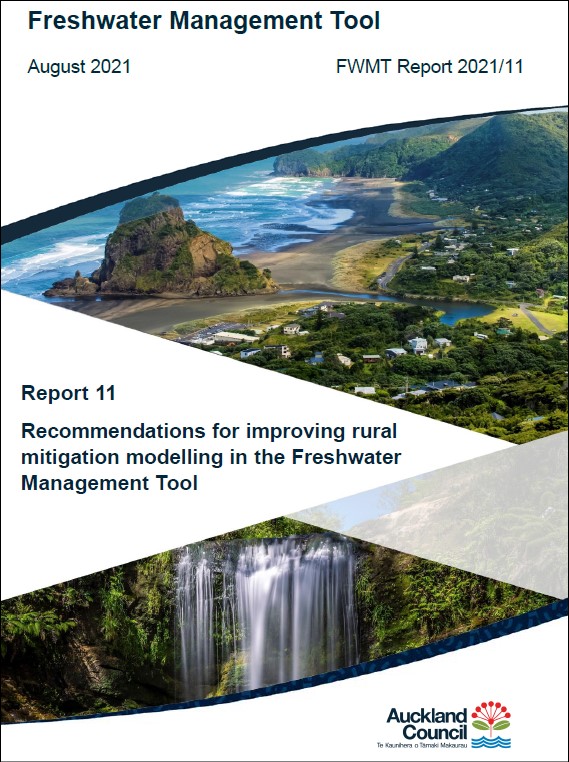Freshwater management tool: report 11. Recommendations for improving rural mitigation modelling
Author:
Auckland Council Healthy Waters Department, Tom Stephens, Perrin Ag Consultants, Carla MullerSource:
Auckland Council Healthy Waters DepartmentPublication date:
2021Topics:
EnvironmentFreshwater management tool: report 11. Recommendations for improving rural mitigation modelling in the freshwater management tool
Executive summary
Auckland Council (AC) has requested that as part of their ongoing development of their Fresh Water Management Tool (FWMT) Stage 1, a staged approach is adopted to refining rural mitigations knowledge (e.g., costs, benefits, granularity, baseline adoption and maximum adoption thereof). The FWMT State 1 is a regionalised, process-based and continuous model able to simulate contaminant and hydrology behaviour throughout the Auckland region at sub-daily resolution and for up to 107 differing sources, spanning a range of biophysical and land use characteristics (e.g., by soil, slope, cover and production type).
To support the FWMT Stage 1, an incremental approach was followed to identifying and informing application of rural mitigation options. Throughout, also engaging with key agricultural sector bodies for feedback and information thereof. In the first step, rural literature was reviewed by Muller et al. (2020a) and Muller and Stephens (2020) while Muller, Ira and Stephens (2020b) translated the literature estimates of cost and efficacy into the a Life Cycle Cost (LCC) Model for application to the FWMT Stage 1. This report is the fourth, highlighting areas for refinement of future FWMT stages in relation to the rural sector mitigations (e.g., choices of, cost and benefits for, granularity of across contaminant sources and regionalization for Auckland farm systems).
This report is intended as a discussion document. It summarises the key limitations and areas for refinement from Muller et al. (2020a; 2020b) and Muller and Stephens (2020) as well as issues highlighted as part of initial industry engagement. The report develops a roadmap for working with key agricultural sectors to develop refined evidence for the FWMT Stage 2.
The FWMT has prioritised “defensible simplicity” – adding complexity only where robust evidence exists and is warranted. The FWMT Stage 1 is already a complex model offering remarkable resolution of water quality contaminant sources, pathways, transformation and outcome on waterways (e.g., concentration, grading, loading). The FWMT is being developed, not simply to assess spread in modern-day or baseline (2013-2017) water quality, but also to identify cost-optimised strategies to drive improved water quality and/or maintain water quality in the face of increasing pressures (e.g., development, intensification of productivity and/or climate change). For that purpose, pastoral and horticultural HRUs, require a library of mitigation options to be developed. Development of a mitigation option requires three fundamental logical conditions:
1. Cost – the reduction in profit (including ongoing maintenance costs), necessary capital outlay associated with a 50-year life cycle of managing a mitigation option;
2. Effect (direct contaminant benefit) – the reduction in contaminant(s) associated with a mitigation option;
3. Opportunity – for which HRUs and contaminant(s) a mitigation option is effective, including at baseline (pre-existing) and maximum (potential).
While initial estimates have been provided for these factors in the FWMT Stage 1, there are areas across all three logical conditions that could be improved in successive versions of the FWMT.
This report is structured as follows; Section 1 describes the basis of rural mitigations simulated by the FWMT Stage 1 in national literature, Section 2 offers more detail on the FWMT, Section 3 describes the rural sector mitigations incorporated into the FWMT Stage 1, Section 4 then identifies key cross-sector (pastoral and horticultural) areas of possible improvements whilst Section 5 focusses on sector-specific areas of improvement. The report thereby provides a recommended roadmap for AC to refine rural sector scenario modelling in future iterations of the FWMT, including how to progress on each area of refinement and an indication of an initial prioritisation framework (Section 6) for further consultation.
FWMT report 2021/11
Auckland Council, September 2022
*****
List of Freshwater Management Tool reports
2. Baseline configuration and performance | Report 2, appendices (in preparation)
3. Baseline state assessment (rivers) | Report 3, appendices (in preparation)
4. Current state assessment (lakes). Not published. Inquiries to: fwmt@aucklandcouncil.govt.nz
5. Review of the freshwater management tool. Baseline state assessment (rivers)
6. Literature review of primary sector responses to water quality: efficacy and cost
7. Riparian area management scenarios. Freshwater management tool
8. Lifecycle costs and benefits for rural mitigations in the freshwater management tool
11. Recommendations for improving rural mitigation modelling in the freshwater management tool
*****
Inquiries to: fwmt@aucklandcouncil.govt.nz
